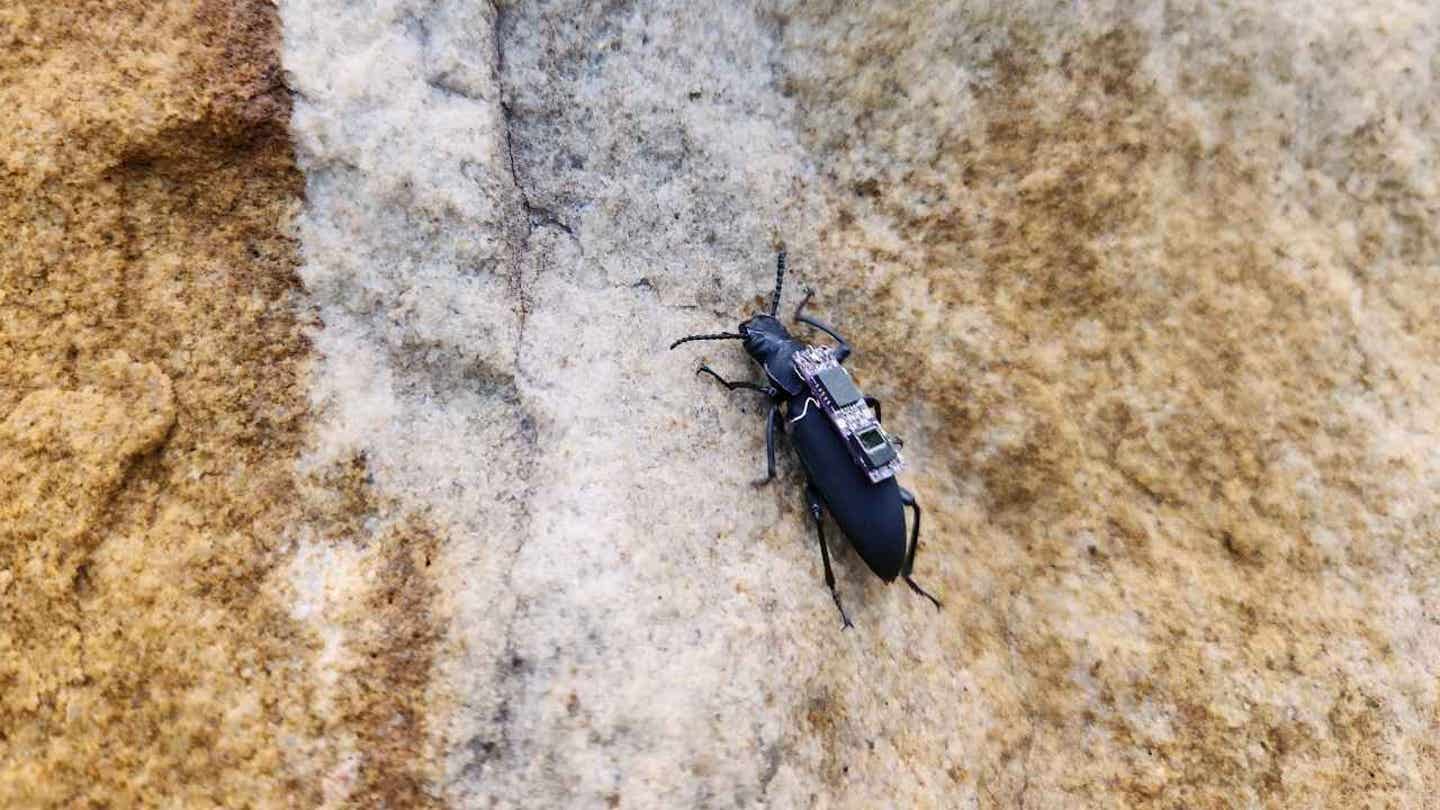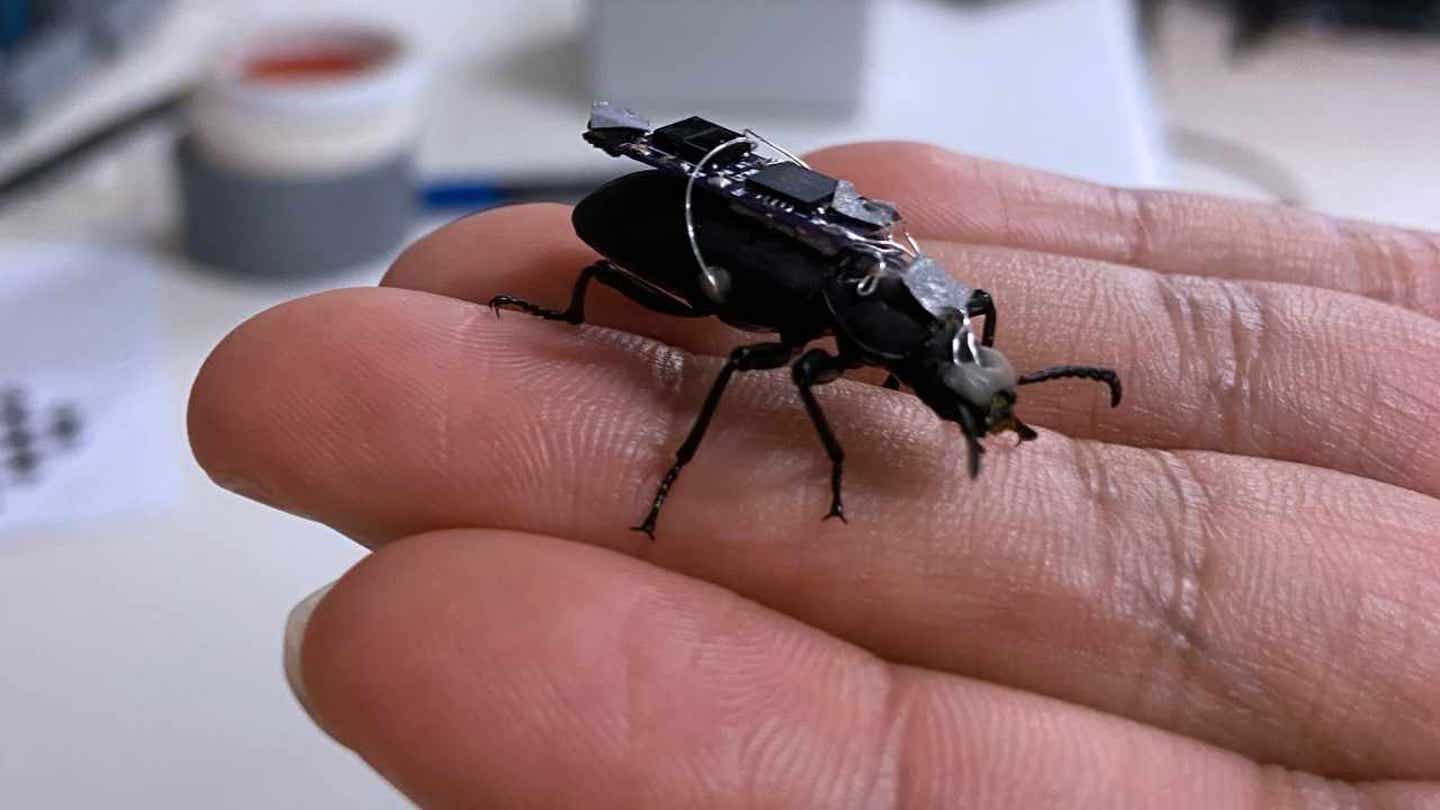NEWNow you can listen to articles from a reliable source!
Researchers at the University of Queensland have developed remote-controlled beetles with tiny, removable backpacks to aid in locating survivors more quickly in disaster zones. This innovative approach combines nature and technology to improve emergency response efforts in scenarios like building collapses, earthquakes, and industrial explosions. These specially equipped beetles, also known as cyborg beetles, offer a faster and more flexible way to access hard-to-reach areas.
The project involves fitting darkling beetles, scientifically known as Zophobas morio, with microchip backpacks that deliver small electrical signals to guide their movements. These signals prompt the beetles to turn, stop, or climb by stimulating either their antennae or forewings. Real-time control can even be achieved using a standard video game controller.
A close-up of a cyborg beetle with mounted electronics. (University of Queensland)
Enhancing Disaster Zone Navigation with Cyborg Beetles
The cyborg beetles have a natural advantage over robots when it comes to navigating disaster zones. While robots struggle with climbing vertical surfaces and traversing uneven terrain, beetles are inherently adept at these tasks. Their footpads and sensory systems enable them to crawl through narrow cracks and over rubble, making them well-suited for the unpredictable conditions found in disaster areas.
Researchers selected beetles for their strength, agility, and resilience. Despite their small size, beetles can carry equipment nearly equal to their body weight, making them ideal for carrying compact sensors and control systems in hazardous environments.

A cyborg beetle with a microchip backpack climbs over a rock’s surface. (University of Queensland)
Biology Influencing Rescue Technology
Unlike conventional robots, cyborg beetles do not rely on motors or gears for movement. Their natural abilities to climb, squeeze, and maneuver through tight spaces eliminate the need for complex mechanical systems. The programmable backpack provides directional control without harming the beetles or impacting their lifespan, resulting in a biological tool that can access areas inaccessible to humans and machines.

A cyborg beetle with a small circuit board on its back sits on top of a person’s hand. (University of Queensland)
The Future of Cyborg Beetles in Emergency Response
Researchers are working on integrating miniature cameras and compact power systems to enhance the effectiveness of the cyborg beetles. The goal is to create a lightweight, mobile, and cost-effective tool that can provide real-time information from within collapsed structures and hazardous environments. The team aims to test the system in a live emergency simulation within the next five years, envisioning cyborg beetles as a valuable asset in urban response efforts worldwide.
Key Takeaway
Cyborg beetles show promise in saving lives by navigating tight, dangerous spaces using small backpacks and simple controls. This low-cost, high-impact technology could prove instrumental in locating survivors quickly, particularly in time-sensitive situations.
Would you trust a rescue operation led by a cyborg beetle? Share your thoughts with us at Cyberguy.com/Contact.
Sign up for my FREE CyberGuy Report
Receive top tech tips, urgent security alerts, and exclusive deals directly to your inbox. Plus, access my Ultimate Scam Survival Guide for free when you join my CYBERGUY.COM/NEWSLETTER.
Copyright 2025 CyberGuy.com. All rights reserved.
Kurt “CyberGuy” Knutsson is an award-winning tech journalist who has a deep love of technology, gear and gadgets that make life better with his contributions for Fox News & FOX Business beginning mornings on “FOX & Friends.” Got a tech question? Get Kurt’s free CyberGuy Newsletter, share your voice, a story idea or comment at CyberGuy.com.





